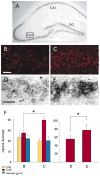Role of hippocampal sodium channel Nav1.6 in kindling epileptogenesis
- PMID: 18637833
- PMCID: PMC3741044
- DOI: 10.1111/j.1528-1167.2008.01710.x
Role of hippocampal sodium channel Nav1.6 in kindling epileptogenesis
Abstract
Purpose: Central nervous system plasticity is essential for normal function, but can also reinforce abnormal network behavior, leading to epilepsy and other disorders. The role of altered ion channel expression in abnormal plasticity has not been thoroughly investigated. Nav1.6 is the most abundantly expressed sodium channel in the nervous system. Because of its distribution in the cell body and axon initial segment, Nav1.6 is crucial for action potential generation. The goal of the present study was to investigate the possible role of changes in Nav1.6 expression in abnormal, activity-dependent plasticity of hippocampal circuits.
Methods: We studied kindling, a form of abnormal activity-dependent facilitation. We investigated: (1) sodium channel protein expression by immunocytochemistry and sodium channel messenger RNA (mRNA) by in situ hybridization, (2) sodium current by patch clamp recordings, and (3) rate of kindling by analysis of seizure behavior. The initiation, development, and expression of kindling in wild-type mice were compared to Nav1.6 +/-med(tg) mice, which have reduced expression of Nav1.6.
Results: We found that kindling was associated with increased expression of Nav1.6 protein and mRNA, which occurred selectively in hippocampal CA3 neurons. Hippocampal CA3 neurons also showed increased persistent sodium current in kindled animals compared to sham-kindled controls. Conversely, Nav1.6 +/-med(tg) mice resisted the initiation and development of kindling.
Discussion: These findings suggest an important mechanism for enhanced excitability, in which Nav1.6 may participate in a self-reinforcing cycle of activity-dependent facilitation in the hippocampus. This mechanism could contribute to both normal hippocampal function and to epilepsy and other common nervous system disorders.
Figures





References
-
- Albertson TE, Joy RM, Stark LG. A pharmacological study in the kindling model of epilepsy. Neuropharmacology. 1984;23:1117–1123. - PubMed
-
- Barco A, Bailey CH, Kandel ER. Common molecular mechanisms in explicit and implicit memory. J Neurochem. 2006;97:1520–1533. - PubMed
-
- Bartolomei F, Gastaldi M, Massacrier A, Planells R, Nicolas S, Cau P. Changes in the mRNAs encoding subtypes I, II and III sodium channel alpha subunits following kainate-induced seizures in rat brain. J Neurocytol. 1997;26:667–678. - PubMed
-
- Bengzon J, Kokaia M, Brundin P, Lindvall O. Seizure suppression in kindling epilepsy by intrahippocampal locus coeruleus grafts: evidence for an alpha-2-adrenoreceptor mediated mechanism. Exp Brain Res. 1990;81:433–437. - PubMed
Publication types
MeSH terms
Substances
Grants and funding
LinkOut - more resources
Full Text Sources
Other Literature Sources
Medical
Miscellaneous

